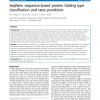159 search results - page 13 / 32 » On delayed prediction of individual sequences |
ACSC
2008
IEEE
13 years 9 months ago
2008
IEEE
Recurrent neural networks are able to store information about previous as well as current inputs. This "memory" allows them to solve temporal problems such as language r...
BIBE
2003
IEEE
14 years 1 months ago
2003
IEEE
The tertiary (3D) structure of a protein contains the essential information for understanding the biological function of the protein at the molecular and cellular levels. Traditio...
BMCBI
2010
13 years 7 months ago
2010
Background: Caspases are a family of proteases that have central functions in programmed cell death (apoptosis) and inflammation. Caspases mediate their effects through aspartate-...
BMCBI
2010
13 years 7 months ago
2010
Background: Protein folding rate is an important property of a protein. Predicting protein folding rate is useful for understanding protein folding process and guiding protein des...
BMCBI
2010
13 years 7 months ago
2010
Background: S. cerevisiae, A. thaliana and M. musculus are well-studied organisms in biology and the sequencing of their genomes was completed many years ago. It is still a challe...

